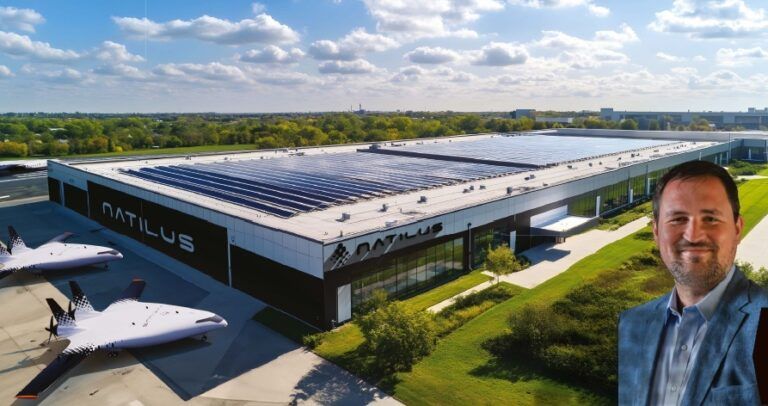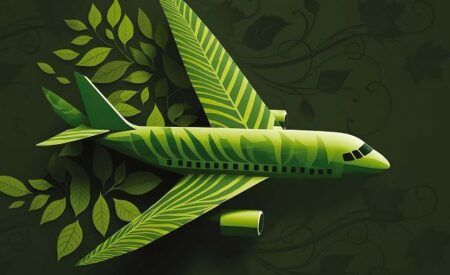The San Diego, USA-based company Natilus has a plan with two phases to bring its blended wing body aircraft to market. The first phase is focused on testing, certifying and beginning production of the Kona regional freighter, then moving on to the 200-seat Horizon commercial passenger aircraft.
Kona and the larger Horizon share the same BWBdesign elements and key technologies. Both aircraft also aim to significantly disrupt their respective markets.
Kona is a Part 23, piloted regional cargo aircraft with an 85ft (25m) wingspan, a 1000 mile (1600km) range. It will be capable of carrying up to 3.8 tonnes (8,400 lbs) of payload. The first Kona customer deliveries are planned for early 2028.
Natilus plans to make up to 60 Konas per year in a 250,000-square-foot factory, employing more than 300 workers in the USA. Boldly, the site selection process for the factory was started earlier this year, before a full scale prototype of the Kona has even flown.
“We are not just building the product, we are building the company,” says Aleksey Matyushev, co-founder and CEO of Natilus. “It became clear last year that to meet our timetable for certification and product delivery meant getting a site ready. That is a three-year process that we had to start.”
“We are not just building the product, we are building the company”
CAREFUL REINVENTION
Natilus’ blended wing body (BWB) design features a slender lifting fuselage, high aspect ratio wings and twin aft-mounted engines. The company claims its aircraft will use 30% less fuel and produce 50% less carbon emissions than similar aircraft, while providing 40% more volumetric capacity.
Despite the radical design, Natilus’ engineers are not looking to completely reinvent the airplane with Kona, which will be powered by two fossil fuel-powered Pratt & Whitney PT6 turboprop engines. “It’s tried and trusted,” says Matyushev. “We always say, never put a new engine on a new airplane. There’s too much risk.”
The company has been flying a sub-scale model of Kona since 2023. The first full-scale prototype is being built in San Diego, with first flight planned in 24 months.
Most of the aircraft is carbon fiber. Some key components, such as the landing gear assemblies and engine mounts, are aluminum or steel-based, but these are in the minority within the aircraft.
Due to the high level of composites in the airframe and the manual nature of manufacturing with such material, Natilus favours locations for the Kona factory site with low labor rates. It is also looking for a region with strong incentive programs and runways, airspace clearance for testing, training and sell-off facilities, and close proximity to supply chains.
A site should be announced this year. “There are four or five states that make the most sense,” Matyushev says.
“Our second and third wind tunnel tests were phenomenal”
SCALING UP TO COMMERCIAL
After Kona, the plan is to start producing the Horizon commercial passenger BWB aircraft in a different massive 2.5 million square foot factory that employs around 3,000 people. This could potentially be sited outside of the USA.
Horizon’s entry-into-service is targeted for some time in the early 2030s. The 118ft wingspan (36m) 200-seater aircraft will be capable of carrying up to 25 tonnes (55,000 lbs) over 4,000 miles (6,500km).
Concentrating on the smaller, non-passenger carrying Kona first has several advantages.
“As we move into the passenger market, we have to create trust with our future customers. That’s a hard thing for a startup to do. It’s important for the financing as well,” says Matyushev.
“What we and a lot of customers like about focusing on the regional freighter first is that it normalizes the configuration and the supply chain. We have a high number of orders for Kona, and it will enable us to scale up the technology and manufacturing with confidence into the passenger market.”
Despite being devised several decades ago and offering capacity advantages, a BWB-configured aircraft has never been developed and deployed commercially.
Matyushev explains the Natilus team has leveraged data from previous BWB programs such as NASA’s X-48.
“It provided a lot of test data that flowed into papers. As we started tackling the concept, we could take the lessons already learnt from that program and solve a lot of the technology challenges, allowing us to move faster,” he says. “Without X-48, it would have been challenging to just start straight away from a testing perspective.” Issues around flight stability and passenger comfort have been barriers to BWB design in the past. Natilus has conducted three wind tunnel tests that have shown they have solved these problems, says Matyushev.
“Our second and third wind tunnel tests were phenomenal. As far as performance data and stability control go, we are stable in each axis, which means we don’t need a complex and expensive fly-by-wire system,” he says.

“A lot of the big industry players have started to falter, innovation has stagnated”
“There are a lot of analysis tools, specifically computational fluid dynamics ones, that have evolved a lot over the last 10 to 15 years. We’re using automated tools all in the cloud.
“AI is helping us solve a lot of these challenges. In terms of the mathematical problems, the speed we can move at has been amazing,” he adds.
PASSENGERS AND APRONS
Another key challenge for Horizon is the seating configuration. With long rows necessary, critics of the BWB design have questioned how fast exiting a BWB aircraft can be during emergencies. Another potential drawback is that passenger comfort may suffer considerably depending on where in the row of seats you sit.
Matyushev says Natilus has already begun to work with airline customers on the LOPA (Location of Passenger Accommodations), essentially the internal layout of the aircraft. This includes decisions about how many classes the aircraft will feature, as well as potential international and domestic configurations.
“Depending on the routes, airlines can configure Horizon closer to 165 passengers, or for a high-density configuration, closer to 220.
“Some airlines want to push it 250 passengers if we can do it. But there are trade-offs surrounding the configuration internally,” says Matyushev.
Horizon is being pitched as a competitor in the Boeing 737 and Airbus A320 narrowbody segment. This has implications for the design. “We’re limited in terms of wingspan, but we are taking care about fitting into existing infrastructure, specifically the same parking spaces as a Boeing, Airbus or other narrowbody,” says Matyushev.
“From my perspective, we have figured out the technology, we are on to getting the aircraft into the air and the operational side,” he says.
Natilus has more than 560 pre-orders, with 400 of those for Kona. The latest customer to have reserved production slots is Canada’s Nolinor Aviation.
Matyushev says, “A lot of the big industry players have started to falter, innovation has stagnated. Next generation narrow body aircraft won’t be delivered until the late 2030s, mid-2040s and it seems like they’re all going to look mostly the same as the current generation.
“Airlines must start thinking about sustainability and economics. To achieve their goals in these areas, we need to look at what we can do outside of the engine, with the airframe. Product differentiation has also become an important factor for airlines.
“People are sick and tired of the duopoly. They are willing to take a risk on new manufacturers with new ideas and concepts.”
Matyushev’s plan may seem over-ambitious, but it is considered and pragmatic and he is convinced the time is right for an alternative design. Nothing less is required to push BWB designs into the air, disrupt the Airbus-Boeing duopoly and end the reign of the tube and wing configuration.





